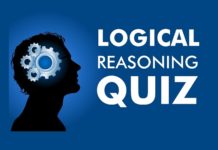Directions (Q. 1-5): Study the following information carefully to answer the given questions:
Eight friends A, B, C, D, E, F, G and H are sitting around a circular table with equal distance between them but not necessarily in the same order. Some of them are facing the centre with some face outside (i.e. opposite to centre). C sits second to the right of F, F faces the centre. Only two people sit between C and B (either form C’s right or ’s left).G sits second to the right of C. H sits to the immediate right of B. G and B face opposite direction. Immediate neighbor of G face the same direction. Only three people sit between D and E. Neither D nor A is an immediate neighbour of F. E sits second to the right of A. Both H and E face a direction opposite to that of C.
1). How many persons sit between E and H? (Count from E, anti clockwise)
a) Three
b) Four
c) Five
d) Two
e) Six
2). D sits to the immediate right of ____________
a) A
b) G
c) Both G and H
d) C
e) H
3). How many persons facing outside?
a) 5
b) 4
c) 3
d) 2
e) 1
4). Which of the following statement is false?
a) C sits immediate left of E
b) B and D faces the same direction
c) G sits opposite to F
d) H sits second to the right of F
e) There are three persons between D and E
5). Which of the following statement is true?
a) H and C faces the same direction
b) G is the immediate neighbour of A and C
c) B sits third to the left of G
d) F faces outside
e) E sits second to the right of A
Directions (Q. 6-10): Study the following information carefully to answer the given questions:
Twelve people are sitting in two parallel rows containing six people each, in such a way that there is an equal distance between adjacent persons. In row-1 J, K, L, M, N and O are seated and all of them are facing south. Inrow-2 U, V, W, X, Y and Z are seated and all of them are facing north. Therefore, in the given seating arrangement each member seated in a row faces another member of the other row.
M sits third to right of K. Either M or K sits at an extreme end of the line. The one who faces K sits second to right of Y. Two people sit between V and Z. Neither V nor Z sits at an extreme end of the line. The immediate neighbour of V faces the person who sits third to left of J. L and N are immediate neighbours of each other. W sits second to the left of U. N does not face the immediate neighbour of X.
6). N faces the person, who is the immediate neighbour of __________
a) U
b) X
c) Both U and V
d) V
e) Z
7). Which of the following person sits immediate right of X?
a) No one sitting
b) V
c) Y
d) U
e) W
8). Which of the following statement is false?
a) N sits second to the right of K
b) L sits immediate right of N
c) W sits at one of the extreme ends
d) U sits immediate right of Z
e) All the options are true
9). If ‘M’ is related to ‘V’, ‘J’ is related to ‘U’, and then which of following is ‘N’ related to?
a) X
b) Y
c) W
d) U
e) X
10). Which of the following statement is true?
a) J sits second to the left of M
b) Y faces the person who is immediate right of M
c) Z sits second to the left of V
d) X sits second to the right of Y
e) W and L sitting at the extreme ends
Direction (Q.11 – 15): Study the following information carefully and the questions given below.
Bharathi, Kaviya, Magathi, Nithya, Oviya, Pragathi, Ramya and Shruthi are sitting around a circular table facing the centre, but not necessarily in the same order. Shruthi sits second to the right of Pragathi. Only two persons sit between Shruthi and Kaviya. Oviya sits opposite to Bharathi, who is not an immediate neighbour of Kaviya and Pragathi. Nithya is the immediate neighbour of Kaviya and Bharathi. Magathi sits third to the right of Bharathi.
11). What is the position of Oviya with respect to Bharathi?
a) Fourth to the left
b) Third to the left
c) Fourth to the right
d) Third to the right
e) Both a) and c)
12). Which of the following pairs represent the immediate neighbours of Pragathi?
a) Ramya and Shruthi
b) Nithya and Oviya
c) Oviya and Ramya
d) Magathi and Kaviya
e) Oviya and Magathi
13). If Magathi is related to Pragathi and Shruthi is related to Nithya, following the same pattern who among the following is related to Kaviya?
a) Oviya
b) Bharathi
c) Shruthi
d) Nithya
e) None of these
14). Which of the following statements is/are true?
a) Magathi is the neighbour of Nithya
b) Oviya is the immediate neighbour of Ramya and Pragathi
c) Nithya sits opposite the one, who sits on the immediate left of Ramya
d) Shruthi sits third to right of Kaviya
e) All the statements are true
15. If Magathi and Shruthi are interchanges their position and Nithya and Ramya are interchanges their position, then who is sitting immediate right of Nithya?
a) Magathi
b) Pragathi
c) Shruthi
d) Ramya
e) Bharathi
Direction (Q.16-20): Study the following information carefully and answer the questions given below.
Twelve persons are sitting in two parallel rows containing six persons each, in such a way that there is an equal distance between the adjacent persons. In row1 P, Q, R, S, T, U are facing south. In row 2 J, K, L, M, N and O are facing north. J is sitting third to the right of M. Either M or J is sitting at the extreme ends of the row. Q is facing J.U is sitting third to the right of Q. S not sits at the middle position of the row. Nis sitting third to the right of K and is not sitting at the extreme ends of the row. T is sitting immediate right of Q. S is facing K. L is an immediate neighbour of neither N nor J. N is facing R.
16). In the row facing south who is sitting at the extreme ends of the row?
a) R, S
b) R, P
c) S, Q
d) R, Q
e) P, Q
17). Who is sitting immediate right of N?
a) M
b) O
c) L
d) J
e) None of these
18). Who are the immediate neighbours of U?
a) S and P
b) S and R
c) P and R
d) S and T
e) None of these
19). If K is interchanges his position with M, similarly L with N and J with O, then who among the following is facing P?
a) L
b) M
c) J
d) N
e) None of these
20). Four of the following five are alike in a certain way based on the given arrangement and so form a group. Which is the one that does not belong to that group?
a) PU
b) RT
c) ML
d) ON
ANSWERS
1. B
2. C
3. A
4. D
5. E
6. C
7. A
8. B
9. E
10. D
11. E
12. C
13. B
14. C
15. A
16. C
17. B
18. C
19. D
20. E













